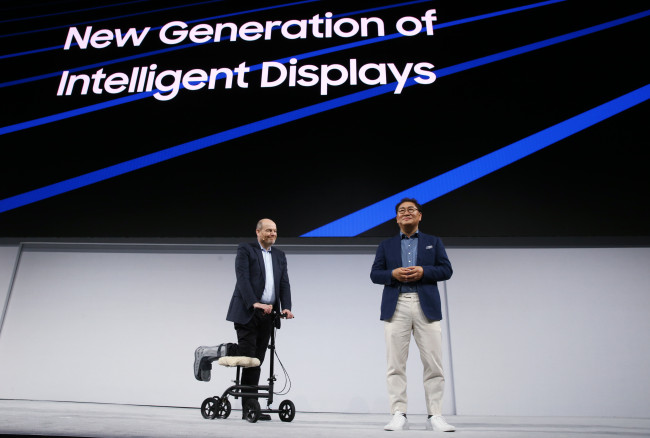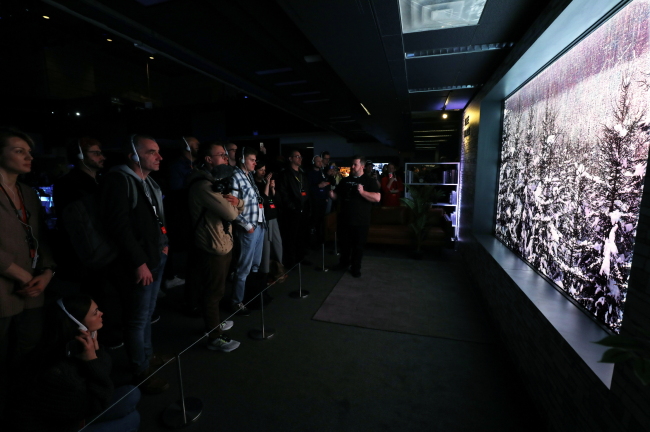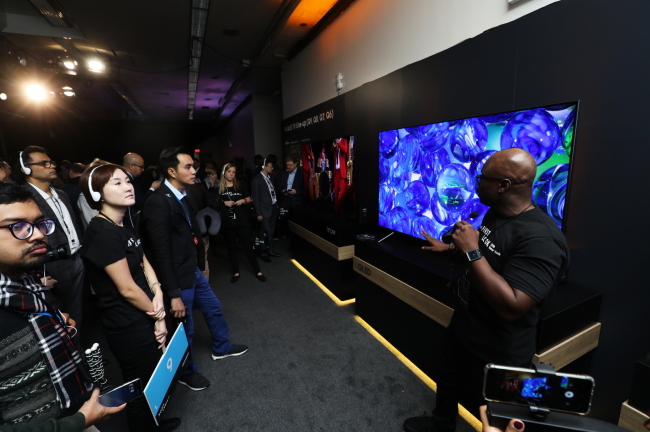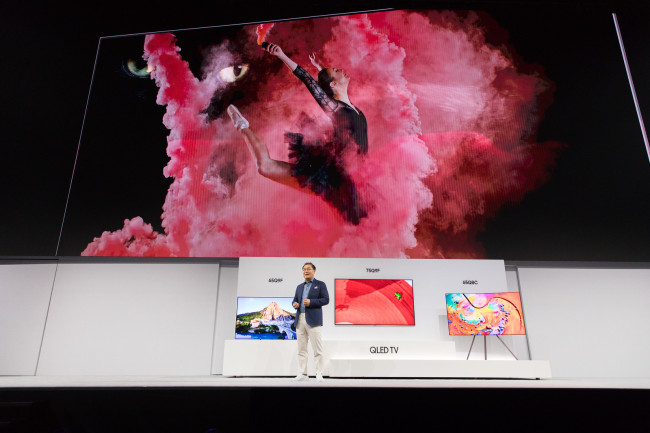[Exclusive] Samsung aims to sell 1.5m QLED TVs this year
Company plans to restore top position in global premium TV market this year
By Song Su-hyunPublished : March 26, 2018 - 17:38
Samsung Electronics’ visual display unit has internally set a goal of selling 1.5 million quantum dot-based light-emitting diode TVs this year in order to make clear its top position in the global premium TV market, according to sources Monday.
“Samsung’s target sales volume for the QLED lineup is 1.5 million, a notable increase from last year’s 1 million,” an industry source told The Korea Herald.

“By selling more of these expensive larger-size TVs than before, Samsung wants to raise the average selling price of its total sales volume,” the source said.
Considering that the South Korean tech giant has cut its annual TV sales volume from about 50 million to between 41 and 42 million units this year, the volume increase in the premium TV lineup suggest a shift in Samsung’s TV strategy. Compared to its thriving smartphone business Samsung has been struggling in the TV sector.

“The strategy is to raise its revenue by concentrating on selling super-sized TVs despite the decrease in the total sales volume,” said a Samsung official.
At the same time, the Korean TV maker is increasing the proportion of UHD TVs in the total sales volume of all TV products from the previous 60 percent to 80 percent to bolster the premium strategy.
With the launches of four models of the 2018 QLED TV lineup (Q6F•Q7F•Q8F•Q9F) in four different sizes each – from 49 inches to 88 inches – in the US on March 18, Samsung has started to strategically focus on new markets for large-size TVs around the world.

Samsung forecasts demand for TVs over 75 inches is expanding by 30 to 40 percent every year. And this year, the company predicts it will sell about 2 million super large-size TVs.
“QLED TVs will offer lower price tags but better picture quality than OLED TVs especially in those large sizes in terms of price-to-quality ratio,” the official said.
Samsung did slash the shipment prices of the latest Q series TVs for the US market by up to 37 percent from last year.
“It seems like Samsung had been agonizing about the prices,” said an industry watcher. “While trying to cover the QLED TV’s weakness that it cannot represent the black color as realistically (as OLED), the company has set the prices lower than OLED TVs to sell more.”
This aggressive change in the TV sales strategy is seen to be aimed at reclaiming the No. 1 position in the global premium TV market.

Samsung was squeezed out to third place in market share of the premium TV market for over $2,500 in 2017 -- after Sony and LG Electronics --, according to data by IHS Markit that does not categorize Samsung’s QLED TV as an independent technology like OLED TV.
The market researcher included the QLED TVs in the LCD TV category, because they are technically based on LCD panels.
Samsung couldn’t announce it was the world’s top TV provider at CES in Las Vegas in January due to this aspect of the data.
According to an industry source, IHS Markit is planning to separately keep track of QLED TVs by adding a quantum dot feature within the existing LCD TV category.
More sales of the QLED TVs would help raise the average selling price and expand the share of Samsung TVs that the market researcher tracks, the source said.
At the annual shareholders’ meeting on Friday, consumer electronics CEO Kim Hyun-suk announced for the first time this year that Samsung was still the global No.1 in the premium TV market for 12 consecutive years.
By Song Su-hyun (song@heraldcorp.com)
“Samsung’s target sales volume for the QLED lineup is 1.5 million, a notable increase from last year’s 1 million,” an industry source told The Korea Herald.

“By selling more of these expensive larger-size TVs than before, Samsung wants to raise the average selling price of its total sales volume,” the source said.
Considering that the South Korean tech giant has cut its annual TV sales volume from about 50 million to between 41 and 42 million units this year, the volume increase in the premium TV lineup suggest a shift in Samsung’s TV strategy. Compared to its thriving smartphone business Samsung has been struggling in the TV sector.

“The strategy is to raise its revenue by concentrating on selling super-sized TVs despite the decrease in the total sales volume,” said a Samsung official.
At the same time, the Korean TV maker is increasing the proportion of UHD TVs in the total sales volume of all TV products from the previous 60 percent to 80 percent to bolster the premium strategy.
With the launches of four models of the 2018 QLED TV lineup (Q6F•Q7F•Q8F•Q9F) in four different sizes each – from 49 inches to 88 inches – in the US on March 18, Samsung has started to strategically focus on new markets for large-size TVs around the world.

Samsung forecasts demand for TVs over 75 inches is expanding by 30 to 40 percent every year. And this year, the company predicts it will sell about 2 million super large-size TVs.
“QLED TVs will offer lower price tags but better picture quality than OLED TVs especially in those large sizes in terms of price-to-quality ratio,” the official said.
Samsung did slash the shipment prices of the latest Q series TVs for the US market by up to 37 percent from last year.
“It seems like Samsung had been agonizing about the prices,” said an industry watcher. “While trying to cover the QLED TV’s weakness that it cannot represent the black color as realistically (as OLED), the company has set the prices lower than OLED TVs to sell more.”
This aggressive change in the TV sales strategy is seen to be aimed at reclaiming the No. 1 position in the global premium TV market.

Samsung was squeezed out to third place in market share of the premium TV market for over $2,500 in 2017 -- after Sony and LG Electronics --, according to data by IHS Markit that does not categorize Samsung’s QLED TV as an independent technology like OLED TV.
The market researcher included the QLED TVs in the LCD TV category, because they are technically based on LCD panels.
Samsung couldn’t announce it was the world’s top TV provider at CES in Las Vegas in January due to this aspect of the data.
According to an industry source, IHS Markit is planning to separately keep track of QLED TVs by adding a quantum dot feature within the existing LCD TV category.
More sales of the QLED TVs would help raise the average selling price and expand the share of Samsung TVs that the market researcher tracks, the source said.
At the annual shareholders’ meeting on Friday, consumer electronics CEO Kim Hyun-suk announced for the first time this year that Samsung was still the global No.1 in the premium TV market for 12 consecutive years.
By Song Su-hyun (song@heraldcorp.com)








![[Graphic News] More Koreans say they plan long-distance trips this year](http://res.heraldm.com/phpwas/restmb_idxmake.php?idx=644&simg=/content/image/2024/04/17/20240417050828_0.gif&u=)
![[KH Explains] Hyundai's full hybrid edge to pay off amid slow transition to pure EVs](http://res.heraldm.com/phpwas/restmb_idxmake.php?idx=644&simg=/content/image/2024/04/18/20240418050645_0.jpg&u=20240419100350)





![[From the Scene] Monks, Buddhists hail return of remains of Buddhas](http://res.heraldm.com/phpwas/restmb_idxmake.php?idx=652&simg=/content/image/2024/04/19/20240419050617_0.jpg&u=20240419175937)

![[KH Explains] Hyundai's full hybrid edge to pay off amid slow transition to pure EVs](http://res.heraldm.com/phpwas/restmb_idxmake.php?idx=652&simg=/content/image/2024/04/18/20240418050645_0.jpg&u=20240419100350)

![[Today’s K-pop] Illit drops debut single remix](http://res.heraldm.com/phpwas/restmb_idxmake.php?idx=642&simg=/content/image/2024/04/19/20240419050612_0.jpg&u=)